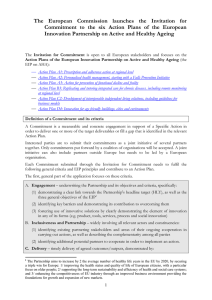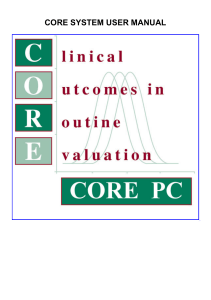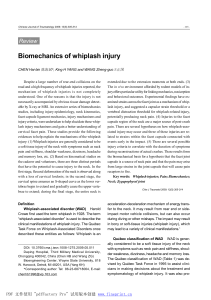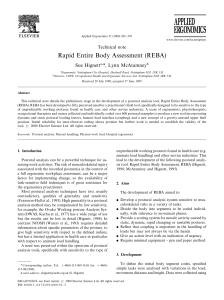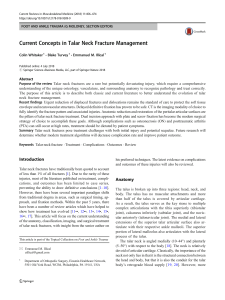The prevention of work-related neck and upper limb disorders
Anuncio
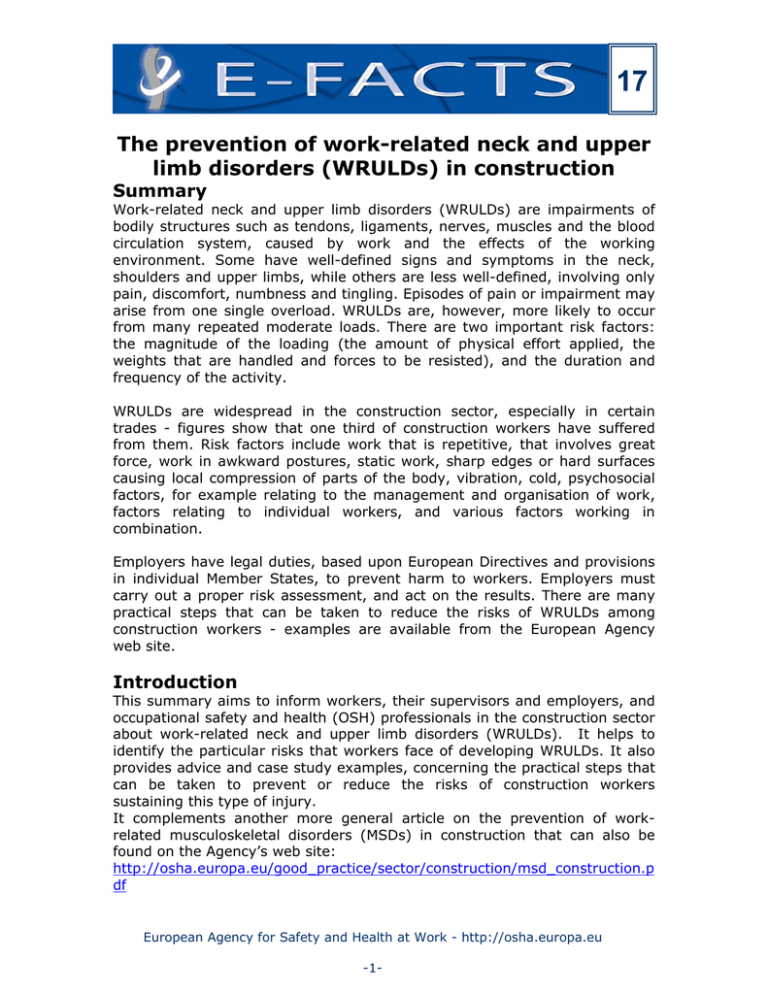
17 The prevention of work-related neck and upper limb disorders (WRULDs) in construction Summary Work-related neck and upper limb disorders (WRULDs) are impairments of bodily structures such as tendons, ligaments, nerves, muscles and the blood circulation system, caused by work and the effects of the working environment. Some have well-defined signs and symptoms in the neck, shoulders and upper limbs, while others are less well-defined, involving only pain, discomfort, numbness and tingling. Episodes of pain or impairment may arise from one single overload. WRULDs are, however, more likely to occur from many repeated moderate loads. There are two important risk factors: the magnitude of the loading (the amount of physical effort applied, the weights that are handled and forces to be resisted), and the duration and frequency of the activity. WRULDs are widespread in the construction sector, especially in certain trades - figures show that one third of construction workers have suffered from them. Risk factors include work that is repetitive, that involves great force, work in awkward postures, static work, sharp edges or hard surfaces causing local compression of parts of the body, vibration, cold, psychosocial factors, for example relating to the management and organisation of work, factors relating to individual workers, and various factors working in combination. Employers have legal duties, based upon European Directives and provisions in individual Member States, to prevent harm to workers. Employers must carry out a proper risk assessment, and act on the results. There are many practical steps that can be taken to reduce the risks of WRULDs among construction workers - examples are available from the European Agency web site. Introduction This summary aims to inform workers, their supervisors and employers, and occupational safety and health (OSH) professionals in the construction sector about work-related neck and upper limb disorders (WRULDs). It helps to identify the particular risks that workers face of developing WRULDs. It also provides advice and case study examples, concerning the practical steps that can be taken to prevent or reduce the risks of construction workers sustaining this type of injury. It complements another more general article on the prevention of workrelated musculoskeletal disorders (MSDs) in construction that can also be found on the Agency’s web site: http://osha.europa.eu/good_practice/sector/construction/msd_construction.p df European Agency for Safety and Health at Work - http://osha.europa.eu -1- The prevention of work-related neck and upper limb disorders (WRULDs) in construction What are WRULDs? WRULDs are impairments of bodily structures such as tendons, ligaments, nerves, muscles, joints, bursa or the localised blood circulation system, that are caused principally by the performance of work and by the effects of the immediate environment in which work is carried out. They include a wide range of inflammatory and degenerative conditions such as shoulder injuries caused by prolonged work above head height, and wrist injuries caused by repetitive work. Symptoms include pain and/or reduced ability to function normally that can affect any region of the neck, shoulders, upper arms, elbows, forearms, wrists and hands. Some of these disorders have well-defined signs and symptoms, for example: • Tendonitis – inflammation and soreness of a tendon resulting from repeated movement of a joint • Carpal tunnel syndrome – damage to a nerve running through the wrist and into the hand, from repeated bending of the wrist whilst holding tools tightly or by constantly pressing the wrist against a hard object • Vibration white finger – numbness and tingling of the fingers, especially in cold weather, resulting from changes to the nerves and blood vessels of the hand through use of vibrating hand tools • Thoracic outlet syndrome – reduced blood flow in the shoulder and arm caused by working above head height or by carrying heavy loads in the hands with the arms hanging straight down. Many other disorders, however, are less well-defined, involving pain, discomfort, numbness and tingling sensations throughout areas of the neck, shoulders, and upper limbs. These types are sometimes called non-specific WRULDs, and often they cannot be diagnosed easily, but do result in physical impairment and disability. How do these disorders occur? Acute episodes of pain and/or impairment may arise from one single excessive overload, for example, direct impacts from heavy mechanical loads can cause ruptures of soft tissues or broken bones. WRULDs are, however, more likely to occur from the effects of many repeated moderate loads during an extended period. Smaller loads may not appear to cause (immediate) injury, but if they are imposed regularly over many months or years, can cause tiring of muscles and lead to microscopic injuries in the tissues. If sufficient time to rest is allowed, the body will grow stronger (this is the goal in training or rehabilitation). If, however, there is not enough time to European Agency for Safety and Health at Work - http://osha.europa.eu -2- The prevention of work-related neck and upper limb disorders (WRULDs) in construction recover from the tiredness, or if the loading is sustained for too long, this can result in WRULDs. Thus, there are two important risks to look out for at work: • The magnitude of the loading: the amount of physical effort applied, including the weights that are handled or the forces to be resisted • The duration and frequency of the physical activity, leading to tiredness and the need for recovery The cost to the worker of WRULDs is pain, along with loss of income through being unable to work. This results in significant cost to organisations through sickness absence or ill-health retirement, and to the state, which may have to support a person unable to work. How widespread are WRULDs in construction? Dutch figures (see below) over a fifteen year period suggest that around one third of construction workers have suffered from WRULDs. Managers and site staff have a lower recorded percentage of complaints than manual workers, but the trend for both groups has been upward in recent years. WRULDs rate Percentage of workers reporting WRULDs 40 35 30 25 20 15 10 5 0 1988-1990 1993-1994 1995-1996 1997-1998 1999-2000 2002-2003 Assessment period Blue collar workers Site management & staff Source: Arbouw-monitor 2005, Arbouw, Amsterdam Trades at higher risk A number of tasks carried out in specific jobs expose the workers concerned to a higher risk of developing WRULDs. These trades include: • Plasterers, including plaster spraying European Agency for Safety and Health at Work - http://osha.europa.eu -3- The prevention of work-related neck and upper limb disorders (WRULDs) in construction • • • • • • • • • • • • Pointers, when filling joints between bricks Screeders making floors level (and exposed to vibration, pulling mechanic tools, manual spreading) Scaffold erectors Tilers Carpenters, when working above shoulder level Glaziers, manual handling, kit cutting, applying kit Bricklayers, especially when handling large blocks Canteen staff, catering and cleaning Insulation workers, when applying mineral wool or polystyrene Plumbers Architects’ staff, undertaking Computer Aided Design Paviours, carrying out repetitive movements, handling heavy materials, and using vibrating equipment. What are the risk factors for WRULDs arising in construction work? Repetitive work Repetitive tasks require the same movements to be made using the same muscle groups, over a prolonged period. Construction work includes manual tasks such as: • Hammering • Drilling • Driving screws • Sawing • Painting with brushes • Plastering • Cutting sheet metal with scissors • Loading and unloading small pieces – like tiles or bricks – to be transported from intermediate storage locations to the final assembly site. All of these activities, when performed repetitively over months and years, can cause WRULDs as there may not be sufficient time for recovery from fatigue, leading to the depletion of energy resources and the build up of metabolic waste. High force applications Exertions that require high muscle forces to be applied can lead to fatigue, and also to injury if there is insufficient time for recovery. Grasping heavy objects needs more force if a pinch grip is used (between the thumb and the fore-finger for thin objects), or if the object is too broad to fit comfortably within the hand. The risk is increased if the wrist cannot be held straight European Agency for Safety and Health at Work - http://osha.europa.eu -4- The prevention of work-related neck and upper limb disorders (WRULDs) in construction when the force is applied. For example, building blocks (weighing around 10kg) are used in the construction of walls. The blocks are held over their top surface in an extended power grip between thumb, palm and fingers whilst being moved from the storage stack and placed in location on the wall. In some locations, the high force levels must be applied with the wrist in awkward postures (i.e. highly flexed or extended dependent upon the height of the lift). Awkward postures Working postures that require a part of the body to be used away from its neutral position, towards the end of its possible movement range, can lead to fatigue, and also to injury if there is insufficient time for recovery. The muscles have to do extra work in order to maintain the posture, when working with stretched arms or in a bent position. Also, the muscles can produce less force in these postures than when in a more comfortable one. This means that muscles will get tired faster in awkward postures, even if the work does not require high muscle forces. Static work Static muscle work involves the continuous contraction of the same muscle groups to maintain the posture of a part of the body, or to hold the force level constant. If such static contractions are held for an extended period, the circulation in the muscles will be disturbed. Fatigue can then occur very quickly and this can result in disorders. With high muscle load, fatigue will force the worker to take a rest. With lower loads the level of fatigue is not so evident, and the worker can spend too long a time in the same posture. Working with the arms extended above the shoulder, or even the head, is common in construction work (for example when painting the ceiling). Working with the arms stretched upwards, the small shoulder muscles have to do more in order to hold the weight of the arms. The load is extremely heavy if the worker also holds a tool or load in the hand far from the shoulder. To see the work being done, the worker also has to bend the neck backwards, which stresses the neck. These situations increase the risk of shoulder and neck disorders. Local compression of tools and surfaces Sharp edges or hard surfaces that cause local mechanical pressure on the area of the body in contact with them can cause harm, if the contact lasts for too long and causes compression of the underlying nerves and other vulnerable structures. Using the hand as a hammer can cause local injuries to the structure and tissues of the hand. The symptoms may not appear during the task but only after a delay of several hours. Work tools should be comfortable and effective to use. European Agency for Safety and Health at Work - http://osha.europa.eu -5- The prevention of work-related neck and upper limb disorders (WRULDs) in construction Vibration Exposure to hand-arm vibration can increase the risk of WRULDs and cause `vibration white finger,’ resulting in loss of sensation and pain in the areas affected. Vibration can be caused by electrically-powered or pneumatic tools that also require higher gripping forces if they are heavy or poorly balanced. Cold Construction work in winter brings additional hazards. Cold hands can result in reduced sensation and more muscle force is needed to hold tools and materials, especially if the worker has to wear gloves. In cold environments, the circulation of blood to muscles is impaired, and maximum strength capacity is diminished. This can lead to the more rapid onset of fatigue and to the development of disorders. Psychosocial factors A range of factors relating to the management and organisation of work, the worker’s psychological responses to the work and workplace conditions, and the overall social environment can affect the development of WRULDs. These factors include the level of work demands, the amount of control that workers have over what they do, and the level of support they receive from managers, supervisors and other workers. The effects of these psychosocial factors are believed to be mediated through stress-related processes that include direct biomechanical and physiological changes. Individual Workers vary in their capacities, and for this reason some may be more likely to develop WRULDs. Individual differences may increase the risks for new employees, younger workers, and those with disabilities, for temporary workers, or for those that come from other countries seeking work. Interactions All of these factors may act on their own, or interact with others to increase the risk of developing WRULDS. The overall loading on the body can be minimised by reducing any of the risk factors. For example, even if the weights handled cannot be reduced, it may be possible to reduce the frequency and duration of handling tasks, so that there will be enough time for recovery. Tools should be designed to meet workers’ needs, have comfortable handles, and make the work easier. With technical assistance such as mechanical aids, it may be possible to shorten the distances that loads must be moved manually. European Agency for Safety and Health at Work - http://osha.europa.eu -6- The prevention of work-related neck and upper limb disorders (WRULDs) in construction What are the tasks that cause the greatest risk? Among the tasks that give the greatest cause for concern are: • All overhead work, especially involving repetitive movements • Plastering • Sheet metal work • Painting • Sanding • Installation of suspended ceilings and panel ceilings • Truck driving, particularly when driving without powered steering, and on uneven ground • Scaffold erection • Tile setting • Rebar tying, when twisting, partly overhead, and handling heavy loads that are hard to control Prevention of WRULDs in construction work All employers have legal duties in their Member States, based upon European Directives, to prevent harm to workers. Two European Directives are particularly relevant to preventing WRULDs among construction workers: • 89/391/EEC - the "framework" directive that sets out the basic requirements for workplaces • 92/57/EEC on the minimum health and safety requirements for temporary and mobile construction sites. The requirements of other European Directives, Standards and Guidelines, together with provisions within individual Member States, may also be relevant to the working conditions found within the construction sector and the prevention of WRULDs. See the Agency’s website for more information on the European legislation relating to the protection of workers: http://osha.europa.eu/legislation Risk assessment It is most important that a suitable assessment is carried out of the hazards and risks in the workplace, to provide the basis for making improvements. Employers are required to evaluate risks to safety and health within their workplaces, and then to improve the standards of safety and health for workers and others who may be harmed. This process is called a risk assessment. Risk assessment involves identifying hazards, and then evaluating the extent of the risks involved. The challenge is to eliminate, or at least reduce, the potential for accidents, injury or ill health that arise from working activities European Agency for Safety and Health at Work - http://osha.europa.eu -7- The prevention of work-related neck and upper limb disorders (WRULDs) in construction and tasks. A good risk assessment, therefore, will form the basis for workplace changes to prevent WRULDs, and for introducing changes that will help reduce the costs to businesses from lost output, compensation claims and higher insurance premiums. The person carrying out the assessment should have appropriate training and experience, and the complexity of the risk assessment will depend upon the size and type of site. There are several models for carrying out a risk assessment. Here is one step-by-step approach. 1. Look for the hazards Think about the work that is done and identify what may cause or increase the risk of WRULDs. For example: • Repeated activities such as hammering or drilling • Having to carry out work above shoulder height. Talk to the workers and their supervisors. Involve them in the risk assessment process and tell them what you are doing to reduce risk. 2. Decide who may be harmed and how Think about everyone who may be injured. Specific attention should be paid to workers in trades where they may face higher risk. 3. Evaluate the risks and decide on action Consider how exposure to risks may lead to WRULDs: • Can the hazard be removed completely? • Can the risk be controlled? • Can steps be taken to protect the whole workforce? • Is personal protective equipment needed to protect workers from risks that cannot be prevented collectively? For example: • Can mechanical handling aids be used to remove or reduce the need to handle materials? • Is particular hand protection required for some tasks? 4. Take action After completing the risk assessment, list the preventive measures needed in order of priority, then take action, involving the workers and their representatives in the process. Actions should be focused on preventive European Agency for Safety and Health at Work - http://osha.europa.eu -8- The prevention of work-related neck and upper limb disorders (WRULDs) in construction measures (to stop the injury or ill health occurring in the first place), but consideration should also be given to measures to minimise the seriousness of any injury sustained. As a part of prevention, it is important to ensure that all workers receive appropriate information and training. Provide good documentation of the hazards and risks that have been identified, of the groups who are at greatest risk, and the kind of injury they may suffer. Provide information on the measures you have introduced to improve health and safety in the workplace, and on ways to avoid specific hazards and risks. When considering preventive actions, look at the: • Workplace – e.g. can the layout be improved to avoid tasks requiring high force applications in awkward, static working postures? • Work equipment – e.g. are the tools that are in use ergonomically designed? Can powered tools be used to reduce the force required for a task? Will the use of such tools, increase exposure to hand-arm vibration? • Workers - workers must be trained to increase their awareness of ergonomic factors, and to recognise and avoid unsafe working conditions. Furthermore, workers must understand why it is important to pay attention to prevention, and what might happen if this is neglected. They should also be made aware of the benefits of adopting good practices and work methods. • Work tasks - One of the most important requirements is to reduce the physical demands of the job by decreasing levels of force required, repetition, awkward postures and/or vibration. This often necessitates the use of material handling devices. • Work management - e.g. better planning of the work or implementing safe systems of work. Is it possible to reallocate tasks between workers to reduce repeated motions, forceful hand exertion, and prolonged bending and twisting? At the organisational level, practical solutions include establishing appropriate work/rest ratios to reduce the build-up of fatigue, organising breaks, and providing job rotation. At the corporate level, a safety culture should be promoted, with stakeholder involvement in identifying and controlling WRULDs risk factors and improving safety and surveillance measures. 5. Review the findings When a significant change is made to working methods, it is important to check that no new hazards are created that need controlling. European Agency for Safety and Health at Work - http://osha.europa.eu -9- The prevention of work-related neck and upper limb disorders (WRULDs) in construction Examples of practical interventions to prevent WRULDs in construction A variety of information for use in preventing WRULDs is available from the European Agency web site: http://osha.europa.eu/topics/msd. Some specific examples of interventions and case studies from the construction sector are given below. Narrow boards for drywall i The use of 90 cm instead of 120 cm boards in drywall construction. The use of narrow boards resulted in less overall physical strain, although more screw-driving effort was required, both overhead and below knee level. The development of other fixing techniques is recommended. Window panes: mechanical kit remover Before a window pane can be removed (either to be replaced or repaired), the time-hardened seal must be broken and forcibly cut away. Traditionally this has been done with a non-mechanical hand tool, requiring large forces and uncontrolled movements. A mechanical cutter solves the problem, and also allows safer working methods to be used. A new tool for rebar work Rebar tying involves stooping and a large number of twisting movements of the wrist and forearm. Dutch designers have developed a new batterypowered tool for binding the rebar at floor level. It eliminates both the need for a stooped posture and the twisting motion of the wrist and arm. Mounting window panes ergonomically ii Glaziers undertake a range of physically demanding tasks when fitting window panes, including the manual handling of heavy weights, lifting, carrying and climbing ladders. They must also adopt awkward, static postures when cutting and fitting heavy glass window panes. New equipment has been developed to overcome these problems, in close collaboration with glaziers, and with financial support from employers and trade union representatives. i Moll E, Kuijer PFM, Molen HF van der, Frings-Dresen MHW: Smallere gipsplaten maken lichter werk? Tijdschrift voor Ergonomie, 30(2005), 5,19-26. (Narrow gypsum boards for lighter work? In Dutch) ii Bronkhorst RE, Koningsveld EAP. Smart manual lifting: window pane handling. (In Dutch: Glaszetters: slim tillen). In: Smarter work in practice; examples of work in productive and healthy jobs. Oeij PRA, Jongkind R, Vaas S. TNO Work and Employment, Hoofddorp, Netherlands, 2005 (ISBN 90-5986-120-5) European Agency for Safety and Health at Work - http://osha.europa.eu -10- The prevention of work-related neck and upper limb disorders (WRULDs) in construction The equipment includes items such as a hoist for moving glass panes, a glass cart for moving panes over uneven surfaces, and an aluminium hoist to raise panes into place on a building. Each pane of glass was labelled to show its weight and the new mechanical tools reduce the force levels required during fitting. The introduction of these changes has resulted in: • The elimination of heavy manual lifting and carrying • Better working postures • Lower force levels being required to do the job. Consequently, absenteeism rates have been reduced and the glazing operation have become more productive, as a result of time savings and reduced wastage from damage to the glass panes and window frames. Further benefits include enabling a greater proportion of the working population (including those who are older and less physically strong) to be able to carry out these tasks, and improvements in morale at work through the promotion of a better safety culture. Finally, a cost/benefit study shows a return on the investment in new equipment and working methods well within the first year. Why are interventions effective? Interventions to reduce physical workloads help prevent health impairment and injuries. This is beneficial for workers: workers may lose income during illness, or as a result of reduced capacity in working in their chosen trade, for which they have been trained. For the employer well-organised and ergonomically well-designed work helps to: • Safeguard and maintain the health of workers • Reduce costs in terms of payment during absence, or penalties if workers are disabled • Improve worker performance. Reduced work strain results in higher motivation, improved output, better quality, and reduced failure costs. Studies have proven that the financial value of improved performance is much greater than the reduced cost of injuries. iii,iv iii Koningsveld EAP, Dul J, Rhijn JW van, Vink P. Enhancing the impact of ergonomic interventions. Ergonomics 2005;48(5):559-580. iv Koningsveld EAP. Ergonomics benefits to companies: European similarities and differences. Proceedings of the conference The Commercial Benefits of Ergonomics. Ergonomics Society, Loughborough UK, 2005. European Agency for Safety and Health at Work - http://osha.europa.eu -11-

